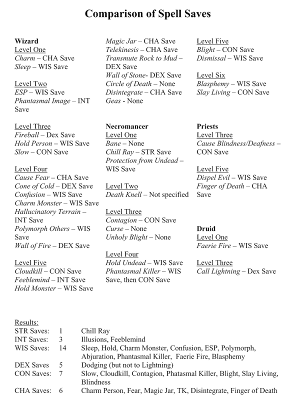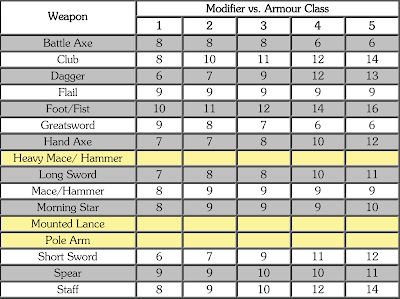SORCEROUS ITEMS
All sentient beings constantly emit low levels of psionic energy (“psions”) which are absorbed by inanimate matter. In this fashion, some psychic sorcerers “read” items through the use of psychometry. The psychic residue of immensely powerful individuals may permeate objects to which they have a long or extremely emotional relationship in such a fashion as to create a psychic imprint of themselves. From this, sorcerous items are brought into existence.
The most usual method of imprinting a sorcerous item is by using an object to kill a being with an exceptional sense of self (CHA 13+). In other cases, the exceptional individual will establish such a long term and volatile relationship with the object (such as a conqueror who uses the same sword in all his battles), that his “psychic shadow” will be left on the item. In either case, it can be seen that all such items are unique; there is no such thing as a “generic” sorcerous item.
For reasons given above, the majority of sorcerous items are tools of war and this category of objects is also called “psychic weapons”. There are other examples, however. The regalia of a Sorcerer-King will become imprinted after centuries of use; these crowns, scepters, and jewels are powerful objects able to bend men’s mind with ease.
The Psychic Shadow
All sorcerous items reflect the personality of their creator. Some are but pale reflections of the former being while others are virtual copies. The strength of the psychic shadow is measured by the items CHA score. Although only beings with exceptional (13+) CHA may serve as the basis of the sorcerous item, not all sorcerous items imprint the full degree of the creator’s essence.
Item Charisma
When a sorcerous item is found, the Referee should roll 3D to determine the CHA of the item. A low CHA item will have only the barest hints of the original left, usually a vague emotion of some sort. Such an item will also have very little in the way of power. The higher CHA item’s will have progressively more coherent personalities, emotions, thoughts, goals, and powers.

Item Goals
Since sorcerous items feel themselves to be alive, they adopt goals. These may range from a yearning to kill for low CHA items to complex plots to control the world by high CHA items. The Referee may assign a goal to any sorcerous items or may roll on the following table:
[which I still need to come up with]
Ego Struggle
Because sorcerous items are the residue of strong egos, they will not simply accept being someone else’s tool. Whenever a sorcerous item is touched, an Ego Struggle occurs. The person touching the item must make a CHA Save, with the object’s CHA modifiers effecting the roll (thus, an object with CHA 18, will levy a -3 to the person’s Save).
If the Save is lost, the character suffers Domination by the item (as per the 2nd level Discipline). The dominated individual will be controlled by the item to further it’s goal—whatever that might be. Items with CHA 8- will have no articulated goal and their domination will manifest more as strange moods.
As with the 2nd level Discipline, a dominated being is entitled to a new Save whenever commanded to something which he finds repugnant. If a subsequent Save is made, the character may toss the sorcerous item aside (or keep it and fight another Ego Struggle).
If the character wins the initial Ego Struggle, it is he who dominates the item, bending it’s psychic shadow to his will. Whenever the item is forced to do something drastically opposed to it’s goal, the character must struggle again to maintain control. If the item wins this subsequent Ego Struggle, it breaks free of its owner. The owner may discard the item or attempt to dominate it again on the subsequent round.
All sentient beings constantly emit low levels of psionic energy (“psions”) which are absorbed by inanimate matter. In this fashion, some psychic sorcerers “read” items through the use of psychometry. The psychic residue of immensely powerful individuals may permeate objects to which they have a long or extremely emotional relationship in such a fashion as to create a psychic imprint of themselves. From this, sorcerous items are brought into existence.
The most usual method of imprinting a sorcerous item is by using an object to kill a being with an exceptional sense of self (CHA 13+). In other cases, the exceptional individual will establish such a long term and volatile relationship with the object (such as a conqueror who uses the same sword in all his battles), that his “psychic shadow” will be left on the item. In either case, it can be seen that all such items are unique; there is no such thing as a “generic” sorcerous item.
For reasons given above, the majority of sorcerous items are tools of war and this category of objects is also called “psychic weapons”. There are other examples, however. The regalia of a Sorcerer-King will become imprinted after centuries of use; these crowns, scepters, and jewels are powerful objects able to bend men’s mind with ease.
The Psychic Shadow
All sorcerous items reflect the personality of their creator. Some are but pale reflections of the former being while others are virtual copies. The strength of the psychic shadow is measured by the items CHA score. Although only beings with exceptional (13+) CHA may serve as the basis of the sorcerous item, not all sorcerous items imprint the full degree of the creator’s essence.
Item Charisma
When a sorcerous item is found, the Referee should roll 3D to determine the CHA of the item. A low CHA item will have only the barest hints of the original left, usually a vague emotion of some sort. Such an item will also have very little in the way of power. The higher CHA item’s will have progressively more coherent personalities, emotions, thoughts, goals, and powers.

Item Goals
Since sorcerous items feel themselves to be alive, they adopt goals. These may range from a yearning to kill for low CHA items to complex plots to control the world by high CHA items. The Referee may assign a goal to any sorcerous items or may roll on the following table:
[which I still need to come up with]
Ego Struggle
Because sorcerous items are the residue of strong egos, they will not simply accept being someone else’s tool. Whenever a sorcerous item is touched, an Ego Struggle occurs. The person touching the item must make a CHA Save, with the object’s CHA modifiers effecting the roll (thus, an object with CHA 18, will levy a -3 to the person’s Save).
If the Save is lost, the character suffers Domination by the item (as per the 2nd level Discipline). The dominated individual will be controlled by the item to further it’s goal—whatever that might be. Items with CHA 8- will have no articulated goal and their domination will manifest more as strange moods.
As with the 2nd level Discipline, a dominated being is entitled to a new Save whenever commanded to something which he finds repugnant. If a subsequent Save is made, the character may toss the sorcerous item aside (or keep it and fight another Ego Struggle).
If the character wins the initial Ego Struggle, it is he who dominates the item, bending it’s psychic shadow to his will. Whenever the item is forced to do something drastically opposed to it’s goal, the character must struggle again to maintain control. If the item wins this subsequent Ego Struggle, it breaks free of its owner. The owner may discard the item or attempt to dominate it again on the subsequent round.








